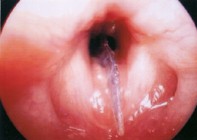Peer Reviewed
Feature Article Respiratory medicine
The coughing child
Abstract
Most children with recurrent cough can be divided into those with asthma and those with recurrent viral bronchitis, based on the presence or absence of wheeze. It is equally important to recognise a smaller group of children with less common causes of cough, as specific therapeutic interventions may be warranted.
Key Points
- There is increasing epidemiological evidence that children who cough in the absence of wheeze (recurrent viral bronchitis) are clinically distinct from children with asthma, and have increased cough receptor sensitivity.
- Children with recurrent viral bronchitis have a self-limiting illness that is usually unresponsive to asthma medication – this treatment should be ceased if there is no therapeutic response.
- Nedocromil sodium (Tilade) may be of some benefit in children with increased cough receptor sensitivity although trials to date have been limited to children with asthma who cough.
- Pertussis and mycoplasma should be considered in children presenting with persistent cough, particularly if there are specific clinical features suggestive of these infections.
- Foreign body inhalation is common in childhood and should be considered in any child with persistent respiratory symptoms, particularly if there are focal signs or radiological changes.
- A history of recurrent or persistent productive cough is suggestive of suppurative lung disease and requires further investigation.
- Cough may occur as a result of upper airway obstruction and improve following treatment of the upper airway pathology.
Purchase the PDF version of this article
Already a subscriber? Login here.

